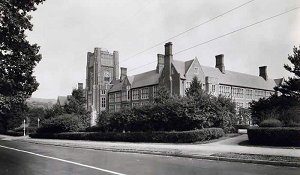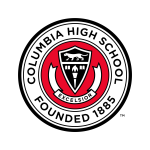
History of Columbia High School
The history of education within the area begins in the early 1700s when itinerant teachers taught the children of the farm families that lived near the Columbia Turnpike which is now known as South Orange Avenue. Eventually a small one story stone building (20 x 30 feet) was constructed and in 1787 there is a record of structural repairs being made upon it. Due to the growing business of the area and rising traffic, the road was widened and the structure got torn down.
The first truly formal funding of the school in what is now the present district of South Orange and Maplewood was done in 1814 by an organization known as "The Proprietors and Associates of the School in South Orange." It was located in South Orange where the town flagpole now stands, with an inaugural class of 30 students. It is also believed, but not firmly documented, that the follow through of patriotic feelings geared by the War of 1812 led to the name, Columbian School, from the then very popular war ballad "Columbia, the Gem of the Ocean." Later, over time and by the start of the Civil War, the name had been changed into Old Academy. However, the community tradition remained strong and not long after the Union's victory in 1865, the school's title returned back to Columbia.
Given the rise in population and the greater need for more detailed higher education, in 1885 Columbia was designated to serve as a "high" school for the community. The first graduating class of 1888 consisted of one student. Eventually the changes brought about by the demands of society made it necessary for a new building to be created. Property for the proposed new school was donated by the Beach Family for perpetual educational use. Thus, in 1927 the school was moved from the center of South Orange to its current location on Parker Avenue and Academy Street. The structural design, done by the firm of Gilbert and Betelle, was so creative and superior that in 1929 the floor plan was placed in the Encyclopaedia Britannica as an exemplary example of school architecture.
The 1927 building, which is still the main center of the current school, has had three additions built to handle larger population numbers generated by the 'baby boom' following the Second World War. Added to the original structure (A Wing) have been the Library/ Television Centers (B Wing in1974), the Physical Educational Areas (D Wing in 1956), and additional classroom spaces (C Wing in 1971). While the C Wing is made up of almost entirely instruction rooms, the other two structures also house settings for teaching in addition to their other main design purposes.
Over the centuries of its operations, Columbia has served as the place in which numerous thousands of persons have learned about the world and how to live life most successfully. In fact the first graduate of Columbia High School, Etta A. Killburn, lived her entire life in the community for well over 80 years. Even given the eventual governmental break that split Maplewood from South Orange, the community was so tied to the school that the population of the time decided to keep one school district even if they chose to have two town halls.
A part of the 1985 celebrations for the centennial of the high school was the creation of the Hall of Fame, which highlights illustrious graduates. The people given this honor are varied in their accomplishments but recognize that Columbia High School was one of the basic reasons why they were so successful. The Hall of Fame Honoree Biographies are available in the Library's Archives Room. It is also the place in which lists of other illustrious graduates are kept along with memorabilia concerning the school and the local community.
Compiled 6/2001 by J. Fanning, Head Librarian, from CHS Archive Information
Schoolcraft. (1929). In Encyclopaedia Britannica, 14th Edition (Vol. 20, p. 96).
NY: Encyclopaedia Britannica.

